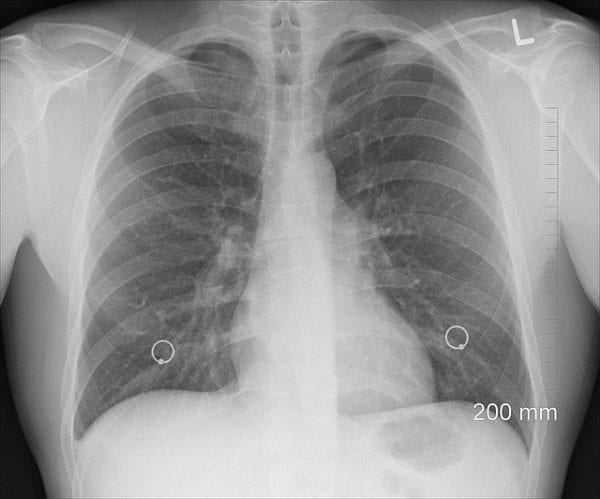Pulmonary toxicology involves the airways, lung parenchyma, mediastinum, pleura, pulmonary vasculature, and the neuromuscular system based on the route of exposure to the offending agent and the dose and duration of exposure. Acute pulmonary reactions are commonly manifested by fever, chills, cough, chest pain, dyspnea, pulmonary infiltration with consolidation or pleural effusion on x-ray, and eosinophilia. Here’s my list of top 5 drugs that cause pulmonary toxicity and their suspected mechanism.
Nitrofurantoin is commonly used in the management of urinary tract infections. One of the possible mechanisms of nitrofurantoin causing pulmonary toxicity is hypersensitivity reactions. The hypersensitivity reaction causes lymphocytes to produce mediators which release many cytokines, resulting in lymphocytic alveolitis. Another proposed mechanism is the induction of the production of oxidants in the lung, activating several inflammatory responses.
In addition to nitrofurantoin, amiodarone is another drug that you may see used in primary care and geriatrics. It likely causes pulmonary toxicity via the production of toxic O2 radicals and an immunological cytotoxic T cell reaction. The risk of pulmonary toxicity increases with higher cumulative doses of amiodarone. Patients who are taking a daily dose of 400 mg or more for more than two months or a daily dose of 200 mg for more than 2 years are at the greatest risk. Here’s more information on the pharmacology of amiodarone.
The mechanisms of bleomycin toxicity possibly includes oxidative damage, the release of inflammatory cytokines, a deficiency of the bleomycin hydroxylase enzyme in the lungs, and genetic predisposition. Some patients develop pulmonary toxicity after the first dose while others may take months to develop.
A small percentage of cyclophosphamide is metabolized into toxic metabolites 4-hydroxycyclophosphamide, acrolein, and phosphoramide mustard in the lungs. This toxic metabolite can cause cyclophosphamide-induced lung fibrosis. This may also depend on genetic differences in local pulmonary drug metabolism.
While potentially not as well understood or as frequently seen in the literature, methotrexate has been associated with pulmonary toxicity. From these case reports, the mechanism of methotrexate-induced toxicity is thought to be a hypersensitivity reaction and/or direct toxic effects from the drug.
There’s our list of top 5 drugs that cause pulmonary toxicity. Although pulmonary toxicity is a rare side effect of these medications, health care professionals should closely monitor patients who are increased risk of developing pulmonary toxicity when prescribed and dispensed these medications. If you ever see the need for escalating doses or new prescriptions of respiratory medications, be sure to look at the medication list to ensure that one of these drugs isn’t causing pulmonary toxicity.
- 30 medication mistakes PDF
- 18+ Page Drug Interaction PDF
- 10 Commandments of Polypharmacy Webinar based on my experiences in clinical practice
Authored by Su Myat in collaboration with Eric Christianson, PharmD, BCGP, BCPS
Study Materials and Resources For Healthcare Professionals and Students – Amazon Books
References
Goemaere NN, Grijm K, van Hal PT, den Bakker MA. Nitrofurantoin-induced pulmonary fibrosis: a case report. J Med Case Rep. 2008;2:169. Published 2008 May 21. DOI:10.1186/1752-1947-2-169
Wolkove N, Baltzan M. Amiodarone pulmonary toxicity. Can Respir J. 2009;16(2):43-48. DOI:10.1155/2009/282540
Ge V, Banakh I, Tiruvoipati R, Haji K. Bleomycin-induced pulmonary toxicity and treatment with infliximab: A case report. Clin Case Rep. 2018;6(10):2011-2014. Published 2018 Sep 4. DOI:10.1002/ccr3.1790
Ulrich Specks. Cyclophosphamide pulmonary toxicity. Uptodate. Accessed on July 2, 2020. Accessed on https://www.uptodate.com/contents/cyclophosphamide-pulmonary-toxicity#H5
Jakubovic BD, Donovan A, Webster PM, Shear NH. Methotrexate-induced pulmonary toxicity. Can Respir J. 2013;20(3):153-155. DOI:10.1155/2013/527912



0 Comments